Tips for management for wire net protection





Make sure that the tree has enough room to grow Do not strangle the tree!

It is Important to monitor and maintain the wire-netting over time.
Wire-netting is only effective against bark-stripping and is most helpful for protecting the tree trunk.
Wire netting does not affect other types of elephant impact such as branch-breaking, stem snapping or uprooting trees.
2. BEEHIVES
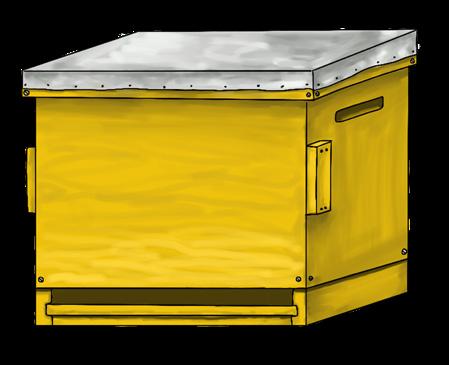
African honeybees have been used to successfully protect crops and trees from elephants.
Did you know elephants are scared of bees?
Elephants have been observed avoiding wild beehives hanging in trees.
Beehives can be used as a method to protect the entire tree.

As elephants have a negative reaction towards bees, hanging hives from trees may encourage elephants to avoid those trees.
Bees have the added benefit of providing honey and functioning as important pollinators
Elephants Alive, www.elephantsalive.org

Beehive Hanging Equipment (EXTRACTED from Elephants, Bees and Trees Manual)

The following equipment is required to hang a single beehive from the branch of a tree:



Credit: Bees and Trees Manual
They have since been used an eco-deterrent to help protect crops and trees.




www.elephantsandbees.com
Cable Ties or wire (200 mm x 5 mm) x 8-12 needed




Nylon RopeLength Equation: 2 x length from branch to 2 m above ground level + 30 cm ( 2 strands needed)
Staples or Nails x 6 Glue
 Wooden board Ladder Hammer Measuring Tape
Credit:
Wooden board Ladder Hammer Measuring Tape
Credit:
Cook, R. M., Parrini, F., King, L. E., Witkowski, E. T. F., & Henley, M. D. (2018). African honeybees as a mitigation method for elephant impact on trees; and King, L.E., Lala, F., Nzumu, H., Mwambingu, E., and Douglas-Hamilton, I. (2017) Beehive fences as a multidimensional conflict-mitigation tool for farmers coexisting with elephants
3.
Method: Pre-Hanging Preparations
Hanging the beehives from the trees
You can use any type of beehive (each hive has its own challenges)
Calculate the length of nylon rope you will need by using the equation


Loop the two ends of both nylon ropes so that each end has a loop, which will be connected to the beehive.
If the beehive is active, use a red-light head torch when hanging the beehive at night. Carry the active beehive to the tree from which the beehive will be hung.

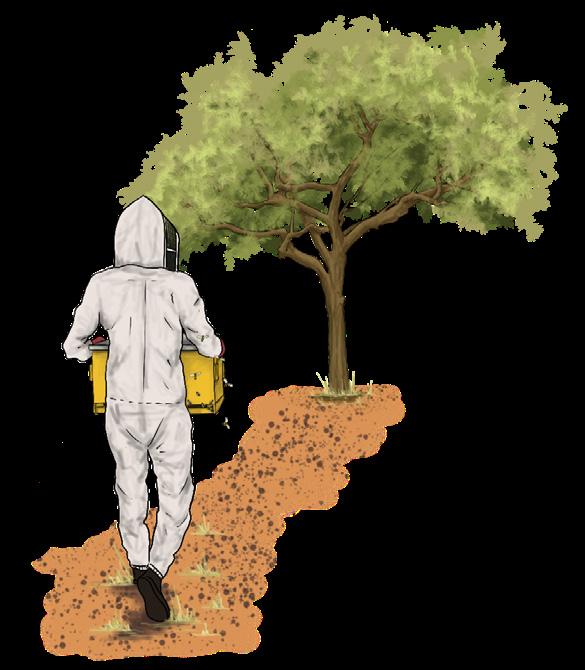


Place one cable tie or piece of wire in each of the beehive’s attachment points
Note: your beehive will need these attachment points for hanging
Place the two nylon ropes over the branch of the tree 50 cm apart.
If needed, hammer in three staples or nails per rope to secure the hanging rope to the tree’s branch.





Make sure you use beekeeping equipment!
Place the ladder next to the four loops. One person will need to help connect the loops to the hanging hive.

The four loops should be in line with one another and 2 m above the ground.
Apply a layer of glue or grease further up each end of the rope using the wooden slab. This is to prevent ants from raiding the beehives.
Two people should lift the active beehive up so that the cable ties or wire can be tied to the loops.



An active beehive can weigh 15 kg!
Once all four corners have been connected to the four loops, add a second cable tie or piece of wire to each loop for extra strength and stability.
Place the board beneath the beehive so that the hive can rest on it. It will need to have a hole in each corner.
Attach the board to the beehive by placing one cable tie or wire in each of the board’s four holes and connect these to the attachment points on the hive.
1. 2.
3. 4. 5. 6.
1. 2.
3. 4.
5. 6. 7.
4.
You should monitor your beehives frequently to ensure that weather and pests do not impact the hive, and to keep an eye of the bees activity.

Natural elements such as rainfall, hail, wind, ants, hive beetles, spiders, honey badgers and elephants can impact a beehive and decrease its chances of survival.
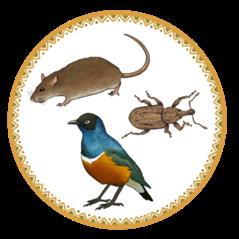

There is a high honey production potential if you look after the hives and encourage healthy colonization!


Credit: Elephants Alive (Resources/Reports) Tree_Protection_Methods_Sept2021

These are best used for small-scale protection, protecting specific trees around an area.













During times of drought or low rainfall, you may need to help feed the bees (you can use sugar solution or nectar supplements)

Providing water for the bees is important. and you can use any container you have available to hold water.

Chicken water feeders are an easy way to provide water for the bees.

Tips for management


The risks include bee-stings Take special care if you are allergic and be sure to have an epi-pen nearby.
Any beekeeping or adjustments to the hives should be done during the early morning or late evening or night when honeybee activity levels are lower and the temperatures are cooler.



Trees with hives without bees are more likely to be visited by elephants, so try and encourage beehive colonization for the most effective results!

Try and avoid using chemical based pesticides as these are not good for natural pollinators like bees.
 Equipment needed for beekeeping Smoker
Equipment needed for beekeeping Smoker
Grease (to prevent ant invasions) Beekeeping knowledge or manual Glue
5.
This method has also been trialed in Gabon, Central Africa. Study found beehives to be a successful deterrent for forest elephants in Gabon, 2016: Credit: Ngama, S., Korte, L., Bindelle, J., Vermeulen, C. and Poulsen, J. R. (2016) How Bees Deter Elephants: Beehive Trials with Forest Elephants (Loxodonta africana cyclotis) in Gabon, PLOS ONE 11 (5) e0155690.
for extra income generation
Good
3. ROCK/PYRAMID BARRIER

This is a ring of rocks or pyramids stacked around the tree’s trunk.
This is good for small-scale application around particular trees.
















Need a good distance between tree’s main stem and the end of pyramids or rocks.
The elephant impact decreases as the pyramid radius around the tree increases. (The wider the barrier of rocks, the more effective this method is)

Tips:
Rocks or pyramids need to be tightly stacked to prevent elephants navigating between the gaps. Rocks or pyramids should be placed upto 4-5 m away from the tree’s main trunk.

PROS/CONS
Beware of scorpions when lifting stones!
4. BEE ATTACK PHEROMONE
Alarm pheromones are released when a bee stings another animal.
This attracts other bees to the same location and causes the other bees to behave defensively.
Credit: Elephants Alive (Resources/Reports) Tree_Protection_Methods_Sept2021
Note: this is still in the testing and research stage.

Take care when moving many large natural rocks around in order to not cause a micro-habitat disturbance.
Physical labour needed.

This can be an effective and low-cost method if done properly.


Bee attack pheromone helps bees recruit more bees from their colony to handle large predators.

The Bee attack pheromone is comprised of chemical compounds which have been manufactured into a synthetically produced Specialised Pheromone and Lure application Technology (SPLAT) paste.
Credit: as mentioned in Elephants Alive (Resources/Reports) Tree_Protection_Methods_Sept2021
TIPS:
86% of elephants encountering pheromone smells in Jejane Private Nature Reserve, South Africa avoided the area.

Results suggest that this method may be effective if elephants already have experience with bee attacks (learnt association).
This is still in the early research phase and not yet available to public.
Can last up to 2 months when applied (weather dependent).
6.
5. NEEM oil










Neem oil is pressed directly from seeds of the Neem tree (Azadirachta indica), which is a tropical evergreen tree native to India.
Neem is an insecticide that controls insects which are harmful in agriculture, forestry and horticulture, and can be used as an alternative to chemical insecticides.
Neem can be effective against more than 400 pests.

Note: this is still in the testing and research stage









Credit: Riaan van Zyl (Consulting and contracting Arborist) as mentioned in Elephants Alive (Resources/Reports) Tree_Protection_Methods_Sept2021
Process
Neem oil is sprayed over the branches and stem of a tree as an elephant deterrent.

The idea is that elephants do not like the smell or taste of neem and will avoid the tree
PROS/CONS
The insecticides may affect other animals.
It also deters other insects from feeding on the treated plant or tree.
It helps disrupts insect development. Insects do not reach adulthood.


Insects are prevented from laying eggs on bioneem plants.

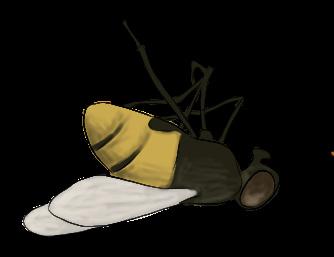
Honeybees and other pollinators may avoid plants with neem.

The short life means that trees will need to be continuously sprayed.



More research is required on this product before being used in a protected area.
6. CHILLI OIL
Chillies have been used as elephant deterrents in sprays, chilli-grease covered fences and dung balls.

Directly paste chilli oil onto the tree stem.
Oil-based chilli lasts longer than water-based chilli.


Credit: as mentioned in Elephants Alive (Resources/ Reports) Tree_Protection_Methods_Sept2021
TIPS
More data is required at a manageable scale.



Use protective wear when working with chilli products.
Reapply every 2-4 weeks. (weather dependent)
 Credit: Osborn FV, Rasmussen LEL. 1995. Evidence for the effectiveness of an oleoresin capsicum aerosol as a repellent against wild elephants in Zimbabwe. Pachyderm 20:55–64.
Credit: Osborn FV, Rasmussen LEL. 1995. Evidence for the effectiveness of an oleoresin capsicum aerosol as a repellent against wild elephants in Zimbabwe. Pachyderm 20:55–64.
7.
Ingredients needed

Clay Buffalo/cattle dung Elephant dung
Clean drum Water Sugar Paint brush
This is an adaptation of an old cow dung and clay tree healing method.
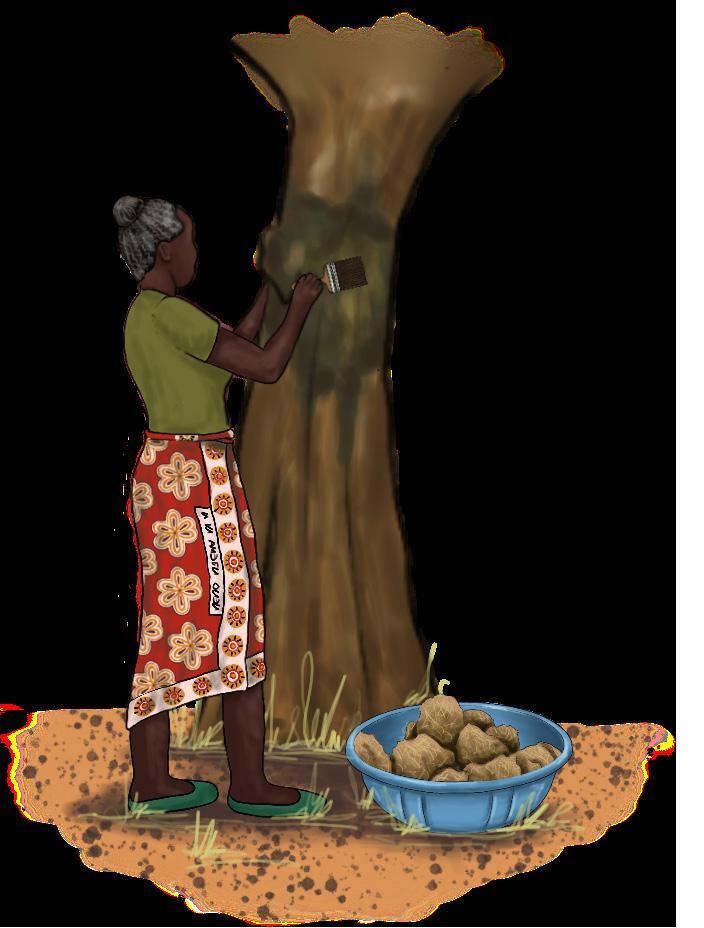
Dung paste has anti-bacterial properties and adhesion elements.
PROCESS
Gather fresh buffalo or cattle manure in a large drum.



(Make sure the drum is clean and does not have chemicals inside.)







Credit: Riaan van Zyl (Consulting and contracting Arborist) as mentioned in Elephants Alive (Resources/ Reports) Tree_Protection_Methods_Sept2021

TIPS:
This is primarily a tree healing method but elephants have been also been observed avoiding dung covered trees in Botswana.
It helps to seals tree wounds and prevents pathogens to otherwise exposed surfaces.
Paste may be washed away with rainfall, so re-apply when necessary.

Caution tips: Tree populations are affected at different growth-stages.


Certain methods are still undergoing testing and caution is required before large-scale usage.









No method is fool proof, but survival rates of big trees can be increased if methods are applied correctly.
Assess the efficacy and appropriateness of methods before using. Use protective wear and safety equipment The use of rubber gloves is advisable when handling chilli. Take care not to touch eyes, mouth and sensitive areas.
Some methods may need technical training and expertise Be sure to have the necessary training experience. (e.g beekeeping)



Case studies from South Africa may need design adaptation in other sites.
Put 100kg of elephant manure in a clean 200 litre drum.
Fill water up to 3/4 level.
1. 2. 3. 4. 5.

Add this dissolved sugar mix to the elephant dung in the drum.
Allow this to ferment for 3 days.
Ensure the final mix is not too fluid-like.
Credits and Disclaimer:
We have collated resources from Elephants Alive (Dr. Michelle Henley and Robin Cook), and Elephants Alive (Resources and Reports)_ Tree Protection Methods_Sept 2021 Some methods represented are experimental and further research is needed. To learn more on using tree protection methods, explore the literature further, see References Save the Elephants advises caution with all the methods collected and presented in this toolbox. Further research may be required before each site-specific implementation.
* Save the Elephants is not liable for any costs, damages or injuries incurred by the use of these methods.


In a separate container, dissolve 2kg of sugar in hot water.


On the day of use, mix the fresh buffalo or cattle manure with the clay and add the fermented elephant ‘tea’ to this mixture.
Use a brush to paint the tree’s main stem, covering as much as you can.

6. 7.
7. DUNG PASTE Produced by Save the Elephants www.savetheelephants.org
Made in Kenya 2023 8.
Illustrations by Nicola Heath






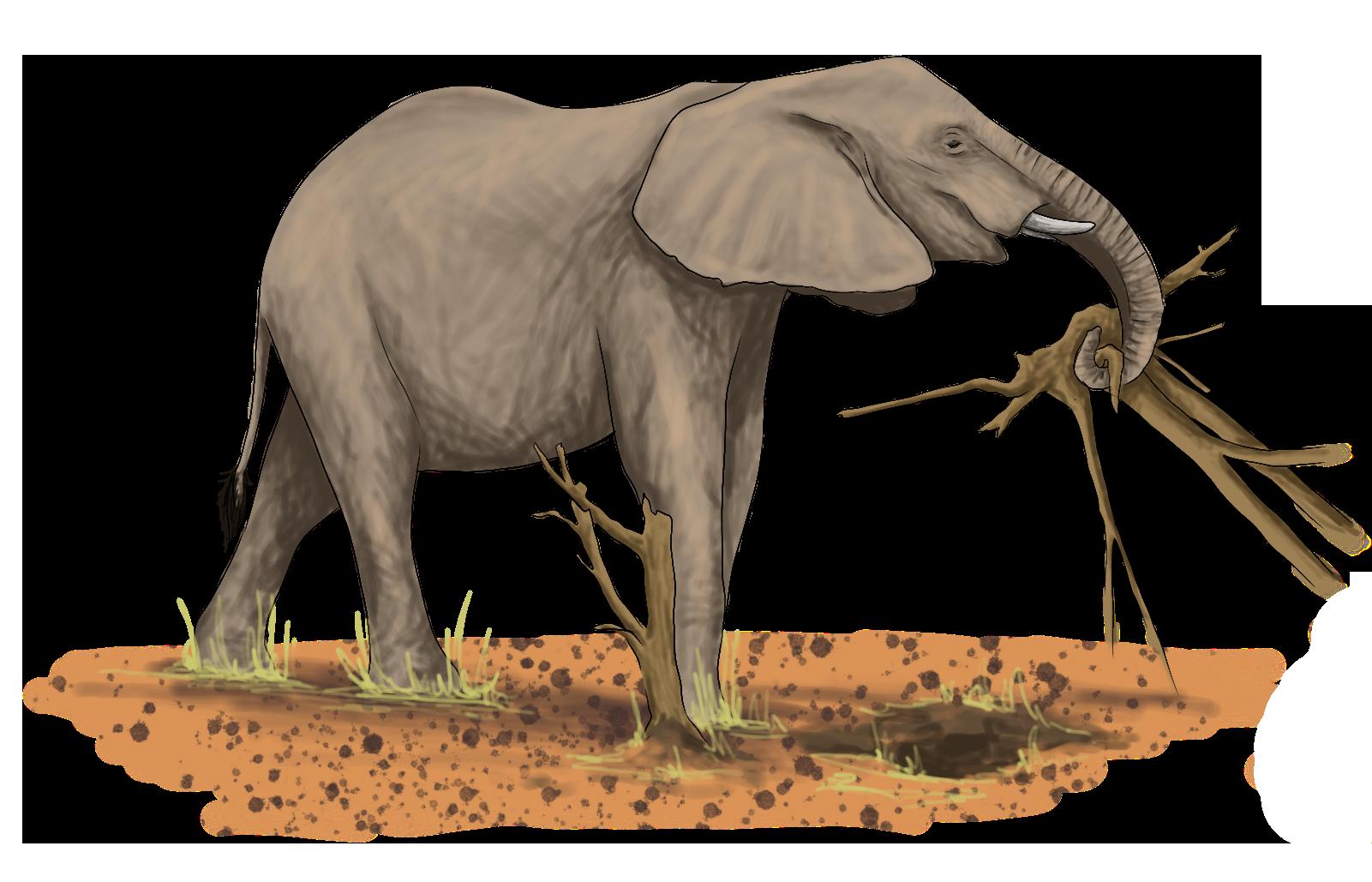




















 Wooden board Ladder Hammer Measuring Tape
Credit:
Wooden board Ladder Hammer Measuring Tape
Credit:






























 Equipment needed for beekeeping Smoker
Equipment needed for beekeeping Smoker
























 Credit: Osborn FV, Rasmussen LEL. 1995. Evidence for the effectiveness of an oleoresin capsicum aerosol as a repellent against wild elephants in Zimbabwe. Pachyderm 20:55–64.
Credit: Osborn FV, Rasmussen LEL. 1995. Evidence for the effectiveness of an oleoresin capsicum aerosol as a repellent against wild elephants in Zimbabwe. Pachyderm 20:55–64.




















